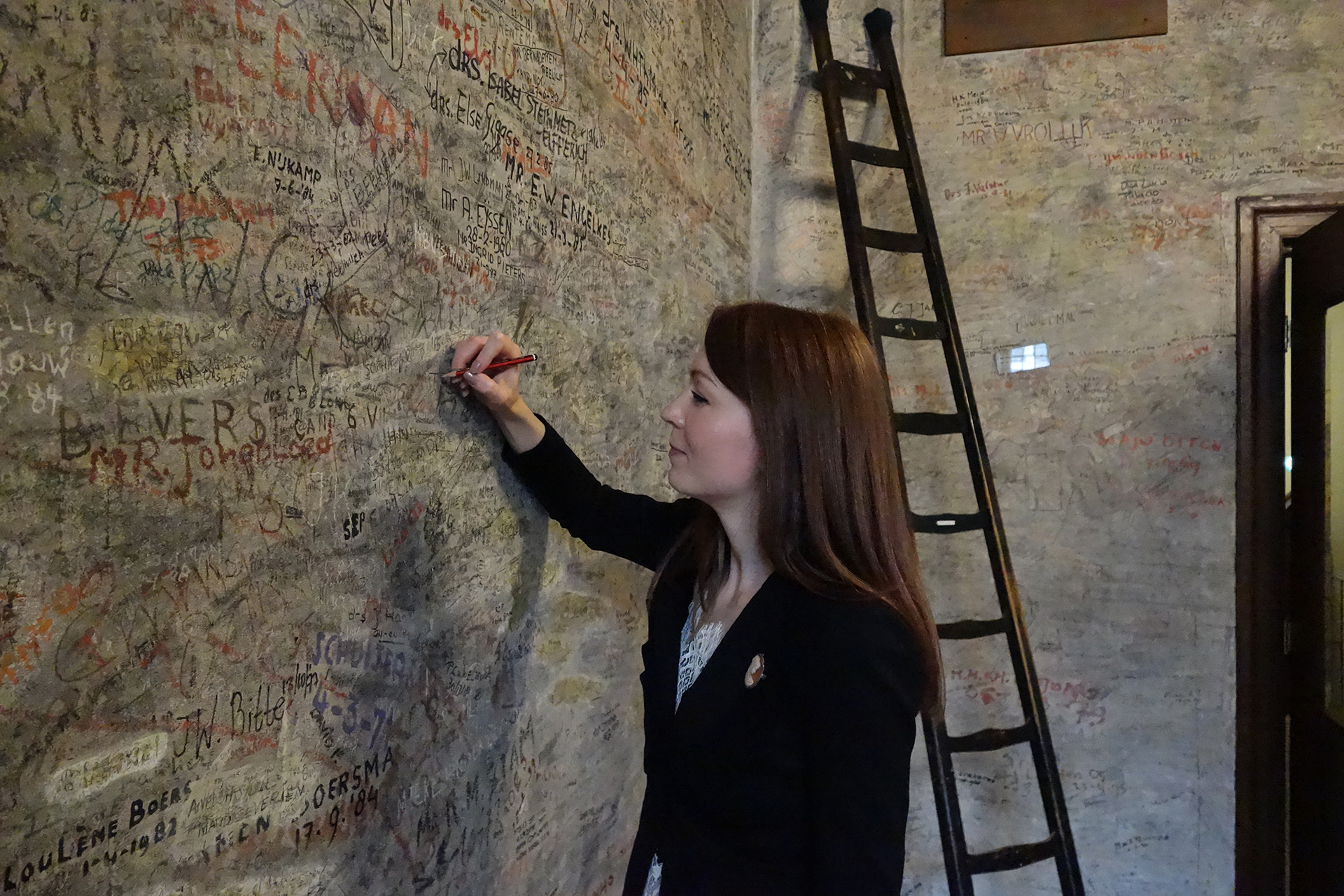
Multimessenger astronomy to study the structure of Milky Way
For centuries, astronomers have studied the universe by collecting light signals. Since 2015, the confirmation of an important prediction of Einstein allows us to explore the universe in a new way: through gravitational wave radiation. Astronomy PhD candidate Valeriya Korol proposes to use these gravitational waves as a tool for studying the Milky Way. Promotion: 19 June.
Gravitational waves
Korol: ‘Gravitational radiation or waves are disturbances in the curvature (fabric) of space-time, generated by accelerated masses. Some of their properties are similar to light. They move at the same speed, can travel in a vacuum, and have a certain frequency and amplitude. But other than light, they are not scattered or absorbed by matter. Albert Einstein predicted the existence of gravitational waves in his general theory of relativity dated 1916. However, their detection became possible only 100 years later. On 14 September 2015, LIGO (Laser Interferometer Gravitational-Wave Observatory) physically sensed the distortions in space-time caused by passing gravitational waves generated by two colliding black holes nearly 1.3 billion light-years away!
‘Gravitational waves are generated by astronomical objects that either do not emit light (such as two merging black holes) or are very faint and practically undetectable, even with state-of-the-art telescopes (such as neutron star and double white dwarfs). Therefore, we can use gravitational waves as a new tool for exploring the “invisible” Universe.’

Multi-messenger sources
Korol focused on so-called double white dwarf systems, which are strong emitters of gravitational waves in our galaxy. Although quite faint, double white dwarfs can also be seen by optical telescopes. Therefore astronomers call them multi-messenger sources. ‘This means that we can collect information from them using more than one messenger’, explains Korol. ‘We use electromagnetic waves, which are the messengers of the electromagnetic field, and gravitational waves, messengers of the gravitational field.’
These two messengers carry very different information, Korol says. ‘From the light, we can find out the chemical composition and temperature of an astronomical object, while from gravitational waves we can learn about their mass and distance.’ From combining different signals from the same object, astronomers can learn much more than from either gravitational wave or optical observations alone. Korol is the first to explore this multi-messenger nature of the double white dwarfs.
Double white dwarfs
In her thesis, Korol proposes a way to use gravitational wave signals from galactic double white dwarfs to study the Milky Way and its neighbourhood. ‘In our own galaxy, the Milky Way, there are many sources of gravitational waves’, she tells. ‘A great example are double white dwarf systems. Within these systems, two white dwarf stars spin around each other in less than 1 hour. They are prolific gravitational wave emitters.’ The new Laser Interferometer Space Antenna (LISA) from ESA will be able to detect the gravitational wave signals from these double white dwarfs.
White dwarfs
Een witte dwerg is één van de mogelijke eindstadia van een ster die het einde van zijn levenscyclus heeft bereikt. Zijn zwakke lichtsterkte komt van de uitstoot van opgeslagen thermische energie, er vindt namelijk geen kernfusie meer plaats in een witte dwerg.
Structure of the Milky Way
Korol discovered that among the approximately hundred currently known double white dwarfs, thirteen emit strong gravitational wave sources and will be guaranteed sources for the LISA mission. Using numerical technique, she predicted that tens of thousands of new double white dwarfs are to be discovered with current and upcoming missions. ‘In particular, I showed that LISA will be able to detect double white dwarfs up to the edge of the Local Group that includes our nearby galaxies. Because merging white dwarfs are believed to be a possible cause of supernovae explosions, this will have important consequences for understanding the origin of these events. Finally, I proved that synergies of gravitational waves and optical observations of white dwarfs can be used to study the structure of Milky Way. By using both sources of information, we can create a more complete map of our galaxy.’
Bridging new and old
Since her childhood, Korol has been intrigued by how our Universe works. Later, at university, she found inspiration in the LISA mission. ‘I truly believe this is the coolest mission ever conceived by scientists!’ Now, her innovative thesis strives to bridge traditional astronomy with the brand new field of gravitational wave astronomy. ‘On the one hand, I used an entirely new type of radiation for studying galactic structure, while on the other hand, I bring well consolidated astronomical techniques to this new field.’ Her contributions build towards an even greater innovation: her beloved LISA mission itself. ‘LISA will be one of the largest space mission conceived by the scientific community in all aspects involving design, engineering, technical testing and theoretical predictions, as in my project.’ LISA is currently under development and is planned to be launched in early 2030.

A prize and a grant for Korol
In April 2019, Valeriya Korol was awarded the prestigious Rubicon Grant by the Netherlands Organisation for Scientific Research (NWO). The Rubicon programme gives young, highly promising researchers the opportunity to gain international research experience. Korol will pursue her own research project shared between the Insitute of Astronomy in Cambridge and the Institute for Gravitational Wave Astronomy in Birmingham. She will start this new journey in the fall. She will continue her work on synergies between electromagnetic and gravitational waves, hoping to provide important implications for Galaxy formation theories and new tests for cosmological models.
Korol has also been awarded the Gruber Foundation Fellowship 2019. . In conjunction with the International Astronomical Union (IAU), The Gruber Foundation (TGF) funds an annual fellowship of US$50 000 for young astronomers. This year the evaluation panel has decided to US$25 000 to two recipients each.
